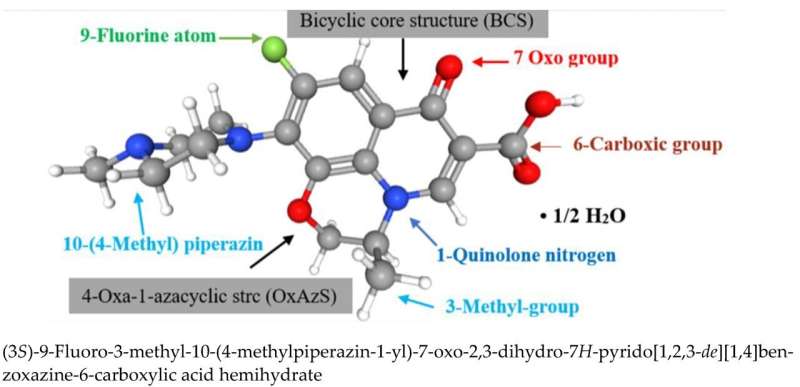This article has been reviewed according to Science X's editorial process and policies. Editors have highlighted the following attributes while ensuring the content's credibility:
fact-checked
proofread
Pharmacists propose ways to increase the activity of levofloxacin and overcome bacterial resistance

The antibacterial drug levofloxacin is used to treat pneumonia, sinusitis, genitourinary infections, and other diseases. It is included in the WHO Model List of Essential Medicines. In terms of its chemical structure, it is a third-generation fluoroquinolone—a completely synthetic substance of the quinolone type.
Generation refers to different modifications of quinolones that are used in different areas. Quinolones of different generations are widely used, but bacteria—for example, pneumococcus and Staphylococcus aureus—develop resistance to them. RUDN University pharmacists studied several derivatives of levofloxacin to find potential candidates for new antibacterial drugs and find out which structural elements are responsible for the biological activity of the substances.
"One of the approaches to improve the kinetic and dynamic characteristics of drugs is to study the properties of the products that are formed as a result of their transformation," Elena Uspenskaya, Doctor of Pharmaceutical Sciences, Professor, Associate Professor of the Department of Pharmaceutical and Toxicological Chemistry of the RUDN University said.
For the experiment, scientists used the pharmaceutical substance levofloxacin. To predict what biological activity its derivatives will have, the authors simulated them, as well as molecular docking "poses" on a computer (in silico). A total of five derivatives and levofloxacin itself were studied. Biological activity was assessed using 7 different types of activity: antibacterial and antitumor effects, inhibition of specific enzymes, and so on.
Modeling made it possible to determine which structural elements of levofloxacin are responsible for its action. Thus, without a carboxyl group in the composition, the antimicrobial activity of the substance is reduced by half. Non-standard actions appear—for example, suppression of the cytochrome P450 enzyme. For some of the most promising modifications, the authors obtained 3D renderings. Based on these results, it will be possible to search for new drugs based on levofloxacin.
"The in silico results allowed us to discover quantitative structure-activity correlations and predict the molecular mechanisms of activity. This is of applied interest for targeted drug search," Elena Uspenskaya, Doctor of Pharmaceutical Sciences, Professor, Associate Professor of the Department of Pharmaceutical and Toxicological Chemistry of the RUDN University said.
The study is published in the journal Scientia Pharmaceutica.
More information: Elena V. Uspenskaya et al, In Silico Activity Prediction and Docking Studies of the Binding Mechanisms of Levofloxacin Structure Derivatives to Active Receptor Sites of Bacterial Type IIA Topoisomerases, Scientia Pharmaceutica (2023). DOI: 10.3390/scipharm92010001
Provided by Scientific Project Lomonosov





















